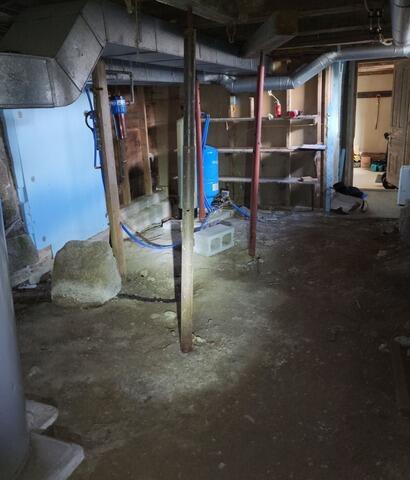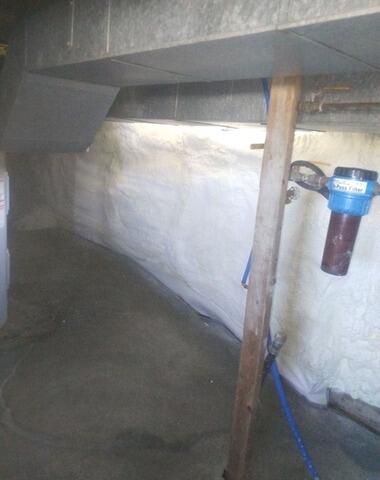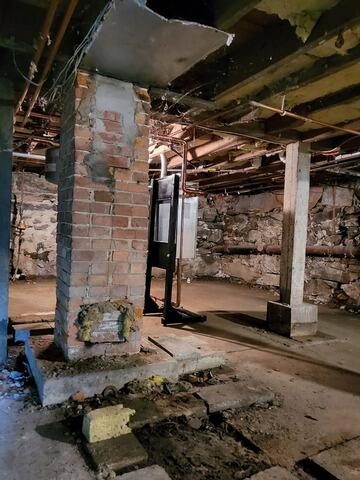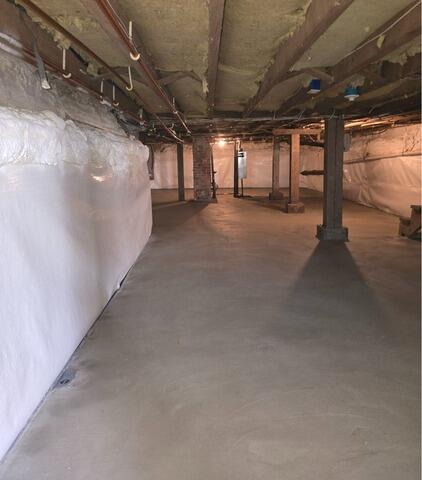Before & After Photos
Click on a photo to enlarge.
CleanSpace Wall System & WaterGuard Piping Protects Brewer, ME Basement from Moisture
This Brewer, ME homeowner never liked to make use of their basement due to the constant damp conditions. They would soon change their mind once they had us over at TC Hafford Basement Systems take a look. Our crew got to work waterproofing this space by surrounding the perimeter of the basement with a WaterGuard piping system buried beneath the floor. These pipes will guide any trapped water to a new TripleSafe sump pump installed in the floor nearby. The TripleSafe will then remove the water from the basement through a discharge line. Lastly, to brighten up the space and keep any moisture on the walls under control, a CleanSpace Wall System was put in place. Now this homeowner can enjoy the utility of a dry basement for the rest of their time spent in this home!
FlexiSpan & SuperSump Installation Protect Brewer, ME Basement from Leaking Water
Living in Brewer, ME, this homeowner was having trouble keeping their basement dry with a crack in the wall leaking during any rainfall. Looking to quickly remedy this problem, the homeowner contacted our office staff at TC Hafford Basement Systems, and we were able to set them up with a free estimate. Following their estimate, they gave us the green light and our installation crew was soon dispatched to the home to begin work. To keep water from entering the problem crack in the future, a FlexiSpan seal was applied over the top of the crack. This seal is built with a foam core to allow structure to bend slightly and remain adhered to any slight changes in the shape of the crack. Once the FlexiSpan seal was complete, a SuperSump pump was installed in the floor of the basement. This device will take in any water that otherwise would have gathered on the floors surface in a pool and force it from the home through a PVC discharge system.
Removing water at a rate over 2,600 gallons per hour, the SuperSump will maintain a dry basement floor for this homeowner for years to come! These waterproofing installations will enable this homeowner to make use of their basement without the need to worry about water damage anymore.
SprayFoam & More in Sargentville, ME
This homeowner in Sargentville, ME, faced a common issue with their newly purchased home: a wet basement with dirt floors. Moisture problems were causing concern for the home structure and air quality. Our team addressed this by installing a TripleSafe Sump Pump, SaniDry Sedona, WaterGuard, and CleanSpace products, as well as SprayFoam to insulate the area. As you can see in the after photo, these solutions provided a clean, dry basement environment. With our expertise, we ensured lasting protection against water infiltration and improved overall home health.
There's Not Still Water in this Stillwater, ME Basement
This Stillwater, ME basement got the complete waterproofing treatment! Before TC Hafford Basement Systems came in, the basement had cracked concrete floors, fieldstone walls that leaked, and no sump pump or dehumidifier. We poured a brand new slab floor complete with slab WaterGuard, a perimeter drainage system. WaterGuard funnels water directly to the new TripleSafe Sump Pump. The TripleSafe has two Zoeller pumps, as well as a battery back up, for full protection against pump failure and power loss. We also added a SaniDry Sedona high efficiency air purifier to filter out dust and mold spores, and maintain a consistent humidity in the space. Water from the SaniDry discharges directly into the TripleSafe, and is then removed far from the home through an exterior buried discharge line.
Stonington, ME Basement Given Full Waterproofing with WaterGuard & CleanSpace Installations
Having lived in this home for most of their life, this Stonington, ME homeowner thought it was time to finally have their dirt basement properly waterproofed. After speaking with our sales representative about what their options were, they hired us at TC Hafford Basement Systems to protect their basement from the usual water leakages. To keep water from building up on the floor in the future, a slab Drainage Matting was laid on the dirt floor before a fresh slab of concrete was poured over the floor. Within this new slab, WaterGuard pipes were buried around the outer edge. These pipes will capture any moisture trying to enter the space through the floor in the future and guide the collected water to the TripleSafe sump pump for removal from the home. Finally, a CleanSpace liner was used to encapsulate the walls of the basement. This will both brighten up the space as well as guide any water coming in through the walls down into the WaterGuard for removal.
With a properly waterproofed basement below their home, this Stonington, ME homeowner can now make use of the space without any moisture negatively affecting their property.










